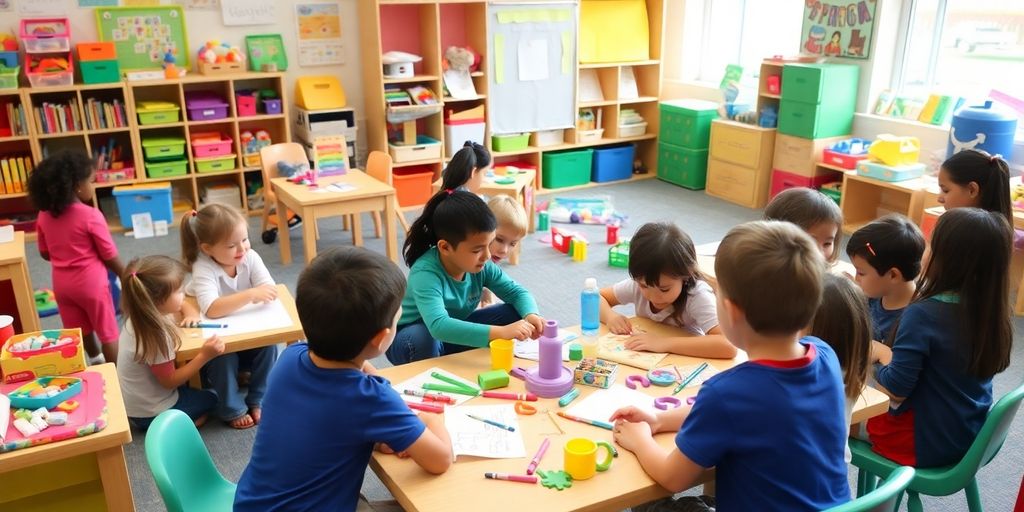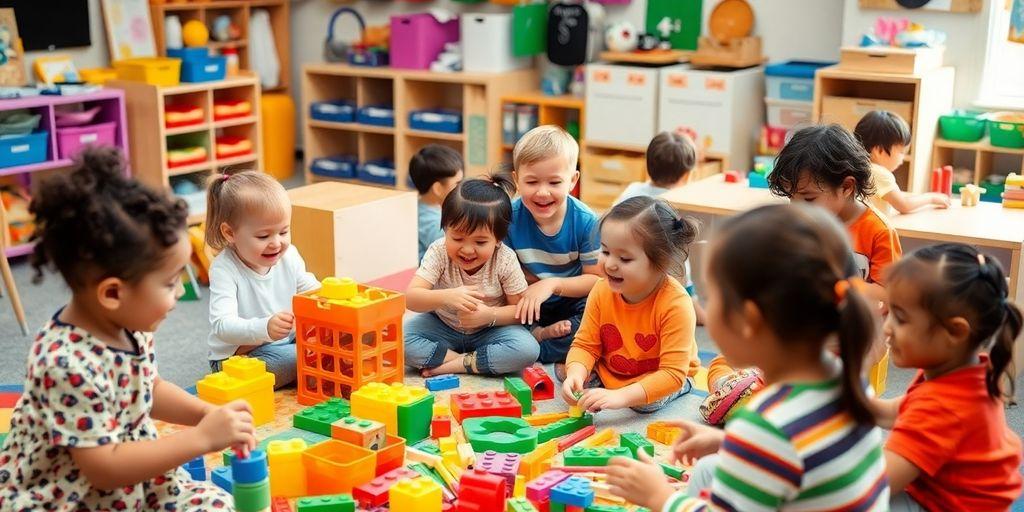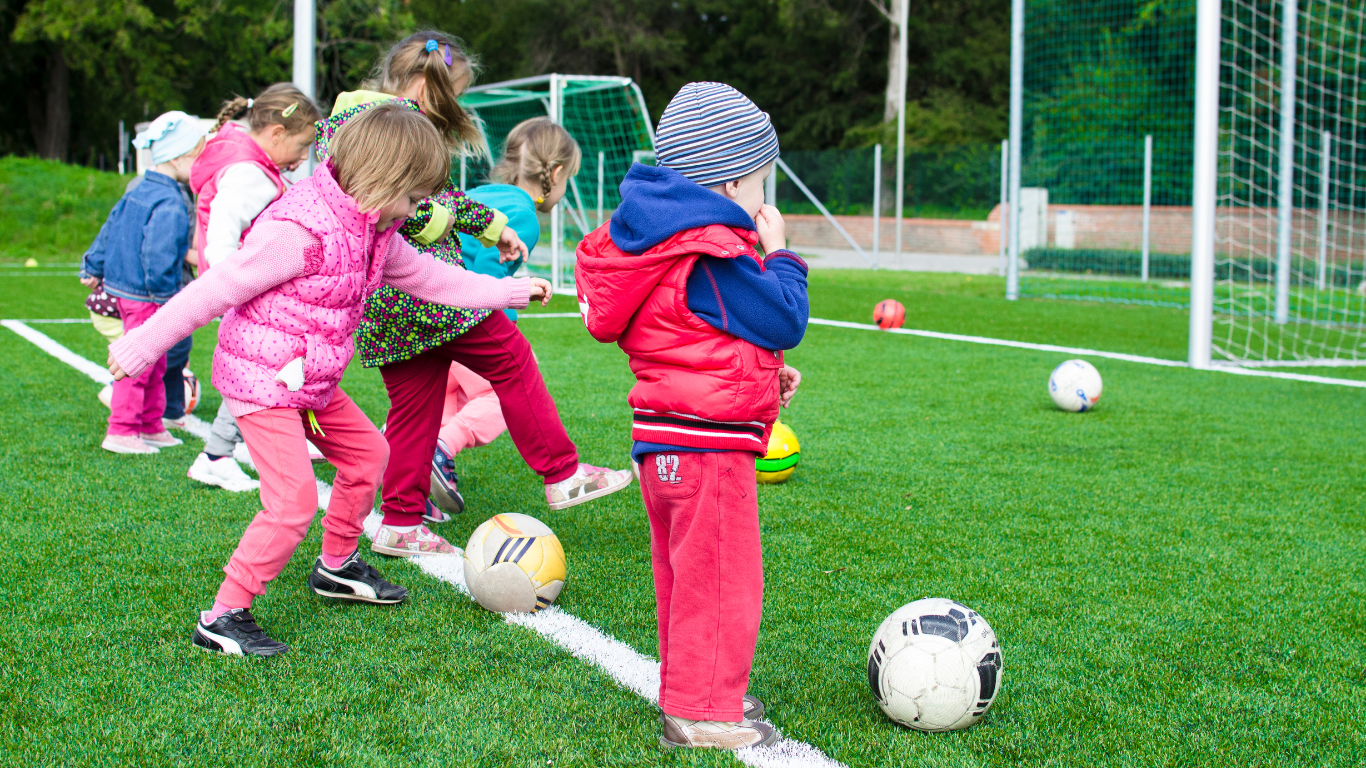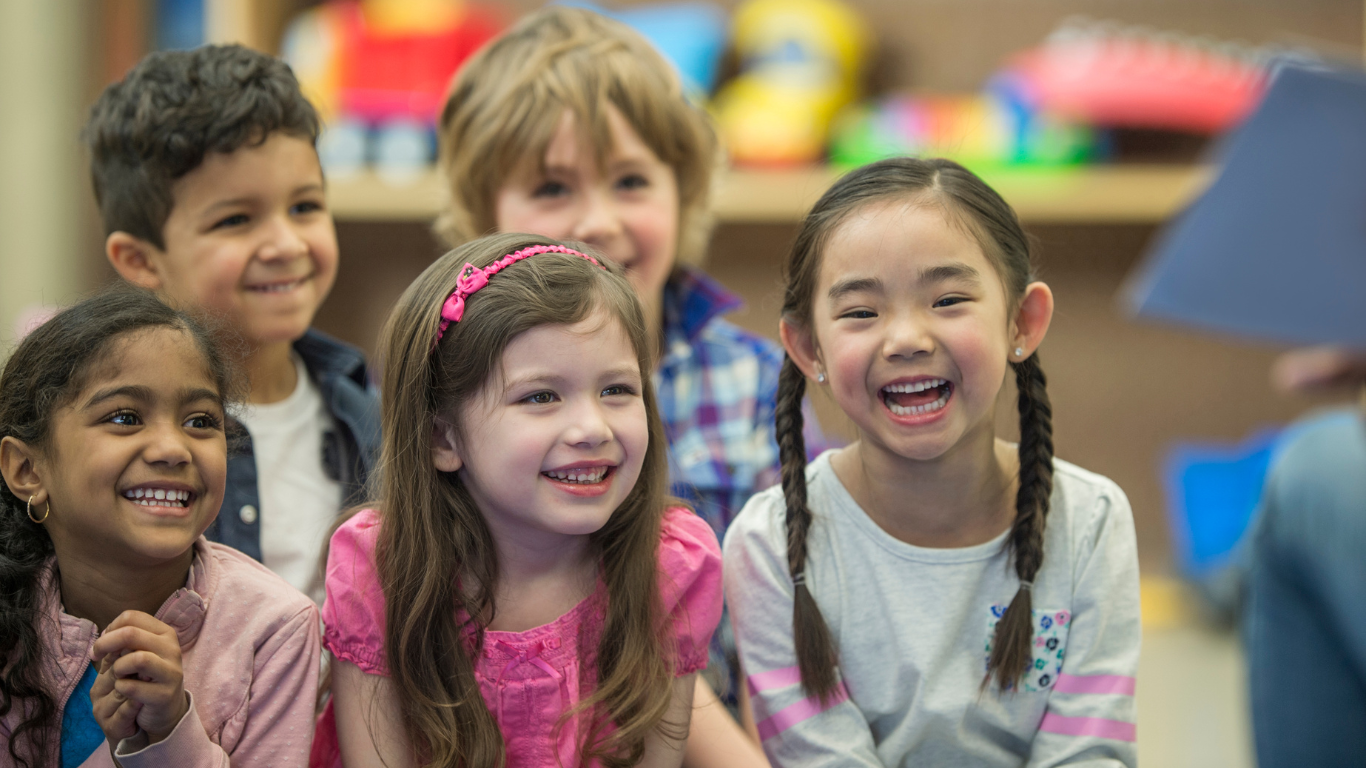
What is Play-Based Learning in Early Childhood
At Warooga Child Care, we believe in the power of play-based learning. This approach allows children to learn and grow through play, which is essential for their development. By integrating fun and exploration into everyday activities, we help kids build vital skills while enjoying their time at our centre. Let’s explore what play-based learning is all about and how it benefits our little ones.
Key Takeaways
- Play-based learning is a natural way for children to learn through exploration and creativity.
- It supports emotional, social, and cognitive development in early childhood.
- Daily routines at Warooga include imaginative play and sensory activities to engage children.
- Educators play a key role in guiding and supporting children during their play experiences.
- Outdoor play and nature interactions are vital for holistic child development.
Understanding Play-Based Learning
Definition and Core Principles
So, what exactly is play-based learning? It’s not just letting kids run wild! It’s a structured approach where children learn through activities they find naturally engaging. The core principle is that children learn best when they are actively involved and having fun. It’s about creating an environment where exploration and discovery are encouraged, and where learning is driven by the child’s interests. Think of it as a way of developmental support for children that makes education feel less like work and more like, well, play!
Benefits for Child Development
Play-based learning offers a stack of benefits for young kids. It’s not just about having a good time (though that’s definitely part of it!). It helps develop:
- Social skills: Kids learn to cooperate, share, and resolve conflicts.
- Emotional skills: They build confidence, resilience, and self-regulation.
- Cognitive skills: Problem-solving, critical thinking, and creativity are all boosted.
- Physical skills: Gross and fine motor skills are developed through active play.
Play is often talked about as if it were a relief from serious learning. But for children, play is serious learning. Play is really the work of childhood.
The Role of Play in Learning
How does learning through play actually work? It’s all about creating opportunities for children to explore, experiment, and discover. Educators set up environments and activities that spark curiosity and encourage children to ask questions and find answers. For example, setting up a pretend shop encourages kids to use maths skills, social skills, and language skills, all while they think they’re just playing shop! It’s amazing to see how children learn through play when they are given the right environment and encouragement. Here are some examples of play-based activities for preschool:
- Building blocks
- Dress-up
- Outdoor games
Integrating Play into Daily Routines
It’s easy to think of play as something separate from the ‘real’ learning that happens at childcare, but that’s not the case at all! Play can, and should, be woven into everything we do throughout the day. It’s about creating opportunities for kids to explore, experiment, and express themselves in a fun and engaging way. How do we do that? Let’s take a look.
Imaginative Play Activities
Imaginative play is where kids get to be anything and anywhere! It’s about providing the props and the space for them to create their own worlds. Think dress-up clothes, building blocks, dolls, toy cars – anything that sparks their imagination.
- Set up a themed play area: One week it could be a doctor’s office, the next a construction site. Change it up regularly to keep things fresh.
- Encourage storytelling: Ask open-ended questions like, “What happens next?” or “Who are you today?”
- Join in the fun: Don’t be afraid to get down on the floor and play along! Your participation can help extend their play and introduce new ideas.
Sensory Tables and Exploration
Sensory play is all about engaging the senses – touch, sight, smell, sound, and taste (though taste should always be carefully monitored!). Sensory tables are a fantastic way to do this. Fill them with different materials like sand, water, rice, pasta, or even shaving cream. Add tools like scoops, cups, and funnels for extra exploration.
Sensory play isn’t just fun; it’s also really important for developing fine motor skills, problem-solving abilities, and even language skills as children describe what they’re experiencing.
Roleplay Scenarios
Roleplay is a great way for kids to learn about the world around them and develop social skills. Set up scenarios like a shop, a restaurant, or a family home. Provide props and encourage them to take on different roles. This helps them understand different perspectives, practise communication, and learn how to cooperate with others. You can even incorporate environmental initiatives into roleplay, like pretending to recycle or plant trees.
Here are some ideas for roleplay scenarios:
- Restaurant: Kids can take turns being the chef, waiter, and customer.
- Supermarket: Set up shelves with empty food containers and let them practise shopping and using money.
- Construction site: Provide hard hats, tools, and building materials for them to build and create.
Alignment with Early Years Learning Framework
Key Learning Outcomes
The Early Years Learning Framework (EYLF) is the backbone of early childhood education Australia. It provides a guide for educators to support children’s learning and development. The EYLF focuses on five key learning outcomes:
- Children have a strong sense of identity.
- Children are connected with and contribute to their world.
- Children have a strong sense of wellbeing.
- Children are confident and involved learners.
- Children are effective communicators.
These outcomes are achieved through play-based learning, where children explore, discover, and create in a supportive environment. It’s all about making sure kids are ready for school and life beyond.
Supporting Educators’ Practises
Educators play a vital role in implementing the EYLF. They use the framework to plan activities, assess children’s progress, and create learning environments that are responsive to individual needs. The EYLF helps educators understand how children learn and develop, enabling them to provide the best possible support.
Here’s how educators use the EYLF:
- Planning engaging and meaningful play experiences.
- Observing and documenting children’s learning.
- Reflecting on their own practise and making improvements.
Framework’s Emphasis on Play
The EYLF places a strong emphasis on play as a vehicle for learning. It recognises that play is not just fun; it’s how children make sense of the world around them. Through play, children develop social skills, problem-solving abilities, and creativity. The framework encourages educators to create play-based learning environments that are stimulating, challenging, and supportive.
Play-based learning, as highlighted in the EYLF, is about creating opportunities for children to explore, experiment, and discover. It’s about letting them lead their own learning, with educators providing guidance and support along the way. This approach helps children develop a love of learning and a strong foundation for future success in early childhood education.
 Educators’ Role in Play-Based Learning
Educators’ Role in Play-Based Learning
Play-based learning isn’t just about letting kids run wild; it’s about educators intentionally creating environments and experiences that spark curiosity and support development. So, what exactly is the educator’s role in all of this?
Guiding and Scaffolding Learning
Educators act as facilitators, observing children’s play and stepping in to extend their learning when needed. It’s about knowing when to let them explore independently and when to offer a gentle nudge in a new direction. For example, if kids are building a tower, an educator might ask, “What if you used triangles instead of squares?” or “How could you make it taller?” These questions encourage problem-solving and critical thinking without taking over the play.
- Observing play to understand children’s interests and skill levels.
- Asking open-ended questions to stimulate thinking.
- Introducing new materials or ideas to expand play possibilities.
Creating a Supportive Environment
A safe and stimulating environment is key to successful play-based learning. This means setting up the physical space with a variety of materials, ensuring emotional safety where children feel comfortable taking risks, and establishing clear boundaries. It also means being responsive to children’s needs and providing support when they encounter challenges. Think of it as setting the stage for exploration and discovery.
A supportive environment also means valuing children’s ideas and contributions, even if they don’t always align with the educator’s expectations. It’s about fostering a sense of ownership and agency in their learning.
Encouraging Exploration and Discovery
Educators should encourage children to explore their interests and discover new things through play. This might involve providing opportunities for experimentation, such as a sensory table with different textures or a construction area with various building materials. It also means allowing children to make mistakes and learn from them. After all, learning is a process of trial and error.
- Providing a range of open-ended materials.
- Allowing time for unstructured play.
- Celebrating experimentation and risk-taking.
The Importance of Nature in Play-Based Learning
Nature offers a unique and irreplaceable learning environment for young children. It’s more than just being outside; it’s about engaging with the natural world in a way that sparks curiosity, encourages exploration, and supports development. Let’s look at why nature is so important in play-based learning.
Outdoor Play Areas
Having dedicated outdoor play areas is super important. These spaces should be designed to encourage kids to interact with nature directly. Think about incorporating natural elements like sand, water, plants, and logs. A well-designed outdoor area can become an extension of the classroom, offering endless opportunities for discovery and learning. Our brand new playground at Southern River is a great example of this, providing a space where children can freely explore and engage with their environment.
Connection to Natural Environments
It’s not just about having an outdoor space; it’s about fostering a real connection with the natural world. This can involve regular trips to local parks, gardens, or even just exploring the school grounds. Direct experiences with nature help children develop an appreciation for the environment and understand their place within it. This connection can also spark a lifelong interest in science and conservation.
Benefits of Nature Play
What are the benefits of play in learning when it comes to nature? Well, there are heaps! Nature play supports physical development by encouraging movement and coordination. It also boosts creativity and imagination as children use natural materials to create their own games and stories. Plus, spending time in nature has been shown to reduce stress and improve mental well-being. It’s a win-win situation!
Nature play is essential for children’s development. It provides opportunities for physical activity, sensory exploration, and imaginative play, all of which contribute to their overall well-being and learning.
Here’s a quick look at some of the key benefits of incorporating nature into play-based learning in childcare:
- Improved physical health
- Enhanced creativity and problem-solving skills
- Increased emotional well-being
- Greater appreciation for the environment
Ultimately, integrating nature into play-based learning enriches the benefits of play-based learning in childcare, providing children with valuable experiences that support their growth and development in all areas.
Fostering Individualised Learning Experiences
At Warooga Child Care, we understand that every child is unique. They come with their own set of skills, interests, and learning styles. That’s why we place a strong emphasis on creating individualised learning experiences that cater to each child’s specific needs. It’s not just about following a set curriculum; it’s about observing, understanding, and responding to each child’s individual journey.
Tailoring Activities to Each Child
How do we make sure each child gets what they need? It starts with careful observation. We watch how children play, what they’re drawn to, and where they might need a little extra support. Based on these observations, we adapt our activities to suit their individual learning styles and developmental stages. For example, a child who learns best through movement might benefit from interactive learning activities that incorporate physical activity, while a child who enjoys quiet reflexion might thrive with individual reading or art projects. We also consider their interests. If a child is fascinated by dinosaurs, we might incorporate dinosaur-themed books, puzzles, and imaginative play scenarios into their learning experiences. This keeps them engaged and motivated to learn.
Building Strong Relationships
Individualised learning isn’t just about adapting activities; it’s also about building strong, trusting relationships with each child. When children feel safe and supported, they’re more likely to take risks, explore new ideas, and ask for help when they need it. We make time to connect with each child on a personal level, listening to their thoughts and feelings, and showing them that we care. These relationships form the foundation for effective learning and development.
Encouraging Confidence and Independence
Our goal is to help children become confident and independent learners. We encourage them to make choices, solve problems, and take responsibility for their own learning. We provide opportunities for them to explore their interests, experiment with new ideas, and learn from their mistakes. We celebrate their successes, big and small, and offer support and encouragement when they face challenges. We believe that by fostering confidence and independence, we’re setting them up for success in school and in life. The importance of hands-on experiences cannot be overstated, as they allow children to learn by doing, building confidence and a sense of accomplishment.
By providing a nurturing and responsive environment, we empower children to become active participants in their own learning journey, fostering a lifelong love of learning.
Transitioning to School Through Play
Transitioning to ‘big school’ is a huge step! It’s not just about learning to read and write; it’s about becoming more independent, making new friends, and navigating a whole new environment. Play-based learning can make this transition smoother and more enjoyable for everyone. It helps kids develop the skills and confidence they need to thrive in a school setting.
Preparing Children for School
Play provides a fantastic foundation for academic learning. Through play, children develop essential skills like problem-solving, critical thinking, and creativity. Imaginative play, for example, encourages children to think outside the box and come up with their own solutions to problems. Building blocks can teach spatial reasoning, and games with rules help children understand the importance of following instructions. These are all skills that will be invaluable when they start school.
Here’s how play helps:
- Literacy Skills: Storytelling, rhyming games, and drawing all contribute to early literacy skills.
- Numeracy Skills: Counting games, puzzles, and building blocks introduce basic mathematical concepts.
- Problem-Solving Skills: Construction toys, puzzles, and imaginative scenarios encourage children to think critically and find solutions.
Building Social Skills
School is a social environment, and children need to be able to interact effectively with their peers and teachers. Play provides opportunities to develop these social skills in a safe and supportive setting. Through play, children learn how to share, take turns, negotiate, and resolve conflicts. They also learn how to empathise with others and understand different perspectives.
Play allows children to practise social interactions in a low-pressure environment. They can experiment with different roles, learn how to communicate effectively, and develop the confidence to interact with others.
Enhancing Emotional Readiness
Starting school can be emotionally challenging for some children. They may feel anxious, scared, or overwhelmed. Play can help children develop the emotional resilience they need to cope with these challenges. Through play, children can express their feelings, explore their fears, and develop coping strategies. They also learn how to regulate their emotions and manage their behaviour. Child development through play is a great way to prepare them for the emotional demands of school. Role-playing scenarios, for example, can help children practise how to handle different situations that they might encounter at school, such as dealing with bullies or asking for help from a teacher.
Playing is a great way for kids to get ready for school. It helps them learn new things, make friends, and feel more comfortable in a classroom. By using fun activities, children can build skills that will help them succeed when they start school. If you want to learn more about how play can help your child transition to school, visit our website for tips and resources!
 Wrapping Up Play-Based Learning at Warooga
Wrapping Up Play-Based Learning at Warooga
In summary, play-based learning at Warooga Child Care is all about letting kids learn through play. This approach helps children develop important skills and knowledge in a fun and engaging way. By incorporating imaginative play, sensory activities, and role-playing into daily routines, Warooga creates a rich learning environment. Educators are there to guide and support the kids, ensuring they get the most out of their play experiences. With a focus on individual care and a connection to nature, Warooga is dedicated to helping children grow and thrive. If you’re looking for a nurturing place for your child, Warooga might just be the perfect fit.
Frequently Asked Questions
What is play-based learning?
Play-based learning is a way for young children to learn through play. It involves activities where children can explore, create, and discover things on their own.
How does play-based learning help children?
This type of learning helps children develop important skills like problem-solving, social skills, and creativity. It also boosts their confidence and independence.
What kind of play activities does Warooga offer?
At Warooga, children enjoy imaginative play, sensory tables for exploration, and roleplay scenarios that allow them to act out different situations.
How does play-based learning fit with the Early Years Learning Framework?
Play-based learning aligns with the Early Years Learning Framework by focusing on key learning outcomes like communication, social skills, and emotional development.
What is the role of educators in play-based learning?
Educators guide and support children during play by encouraging them to explore and discover new things, helping them learn while they play.
Why is outdoor play important in early childhood education?
Outdoor play is vital as it connects children with nature, promotes physical activity, and enhances their overall well-being.




